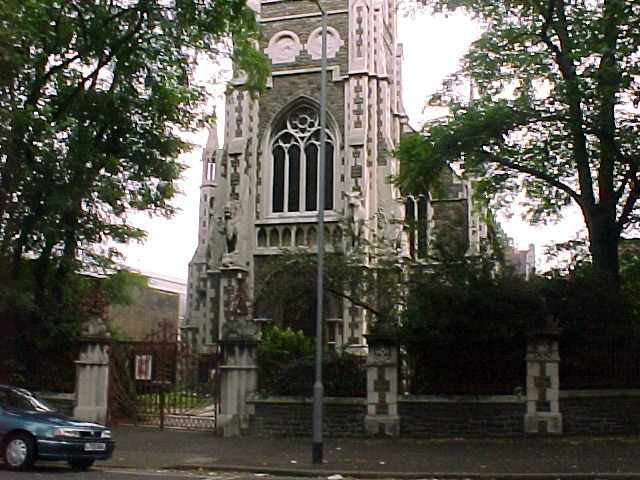Who were the Agapemonites
From Agapemone, literally "the abode of love".
English religious community of men and women, holding all goods in common. It was founded (c.1850) at the village of Spaxton, Somerset, by Henry James Prince (1811-99), Samuel Starky, and others. Prince and Starky were clergymen who had left (c.1843) the Church of England after Prince claimed that the Holy Ghost had taken up residence in his body. |
|

Photo showing front entrance of church
The Clapton Messiah
In 1892 the Agapemonites began the building of a magnificent church at the junction of Rookwood Road and Clapton Common, which they called the Church of Ark of the Covenant. Seating about 400 people this magnificent church, decorated with elaborate symbolism, cost in the region of 20,000 pounds. The preacher at the opening ceremony in 1896 was J H Smyth-Pigott, (later to become Prince`s successor).
The building of the church was paid for with money raised by an Anglican priest named Henry James Prince (1811-99). Prince studied medicine, obtained his qualifications in 1832 and was appointed medical officer to the General Hospital in Bath. Ill-health caused him to abandon his medical profession and subsequently he studied for the priesthood at St David`s Theological College, Lampeter. Shortly after his ordination into the priesthood he became curate of Stoke in Suffolk, but after a while his relations with the Church of England became strained (c 1843). He then opened his own church in Brighton called the Adullam Chapel. Prince`s passionate evanglical ways proved irresistably attractive to the wealthy and the gullible.
Prince claimed that the Holy Ghost had taken up residence in his body thus proclaiming the imminent second coming of Christ.
In 1849 the Agapemonites moved to the village of Spaxton, in Somerset to a 200 acre plot of land and set about creating a self-supporting community of some 60 followers, all dedicated to the Agapemonites unconventional views on marriage, the messiah, immortality and the role of women. The community prospered so much that they were able to build the church in Clapton. Meanwhile, besides attending to the spiritual needs of his flock, Prince also had to attend to the demands of his many brides as women regarded it as a honour to be taken by him as Prince explained in his work "The Little Open Book" (1856).
When Prince died in 1899 he was buried standing up in readiness for the resurrection.
After the death of Prince, John Smyth-Pigott became the acknowledged head of the Agapemonites, born in 1852 in Somerset he had a varied career as a soldier and a curate of the Church of England amongst other things.
Smyth-Pigott fitted the part completely. He was a charming womaniser who managed to convert several members of the Salvation Army to the way of the Agapemonites. All was going well until, on the 7th of September 1902, the assembled congregation noticed that the communion table was replaced by a chair occupied by Smyth-Pigott who proclaimed himself to be the Messiah. He said "God is no longer there" pointing upwards, "but here" pointing to himself. During the following sermon he promised that Christ would appear in due time in the Ark of the Covenant.
In the ensuing riots Smyth-Pigott, the self-proclaimed new Messiah, had to be protected by the police from the violence of an angry mob. Unable to provide proof that he could walk across Clapton Pond he left Clapton with great haste.
Smyth-Pigott returned to the less hostile environs of Somerset where he committed himself vigorously to a demanding succession of brides, reputedly 7 a week. Records of the time show there were nearly 100 women living in Spaxton House.
Smyth-Pigott was defrocked by the Anglican Church under the Clergy Discipline Act, and died in March 1927.
The Agapemonite Church in Clapton was abandoned by the Agapemonites in the 1920s and acquired by the Ancient Catholic Church in 1956 now renamed Cathedral Church of the Good Shepherd.
3rd Feburary 1956, John Betjeman visited the churchhttp://archive.spectator.co.uk/article/3rd-february-1956/
Historian Dr Nick Barratt talks about John Hugh Smyth-Piggot https://www.youtube.com
Wiki Article @ http://en.wikipedia.org/wiki/Agapemonites
A picture of the Clapton Messiah (Smyth-Piggot)can be seen amongst Colin Smith's excellent Agapemone picture collection.
Agapmone "Spaxton" Colin smith's "byegone spaxton" site
The case of the five Nottidge Sistershttp://www.quantockonline.co.uk
|

